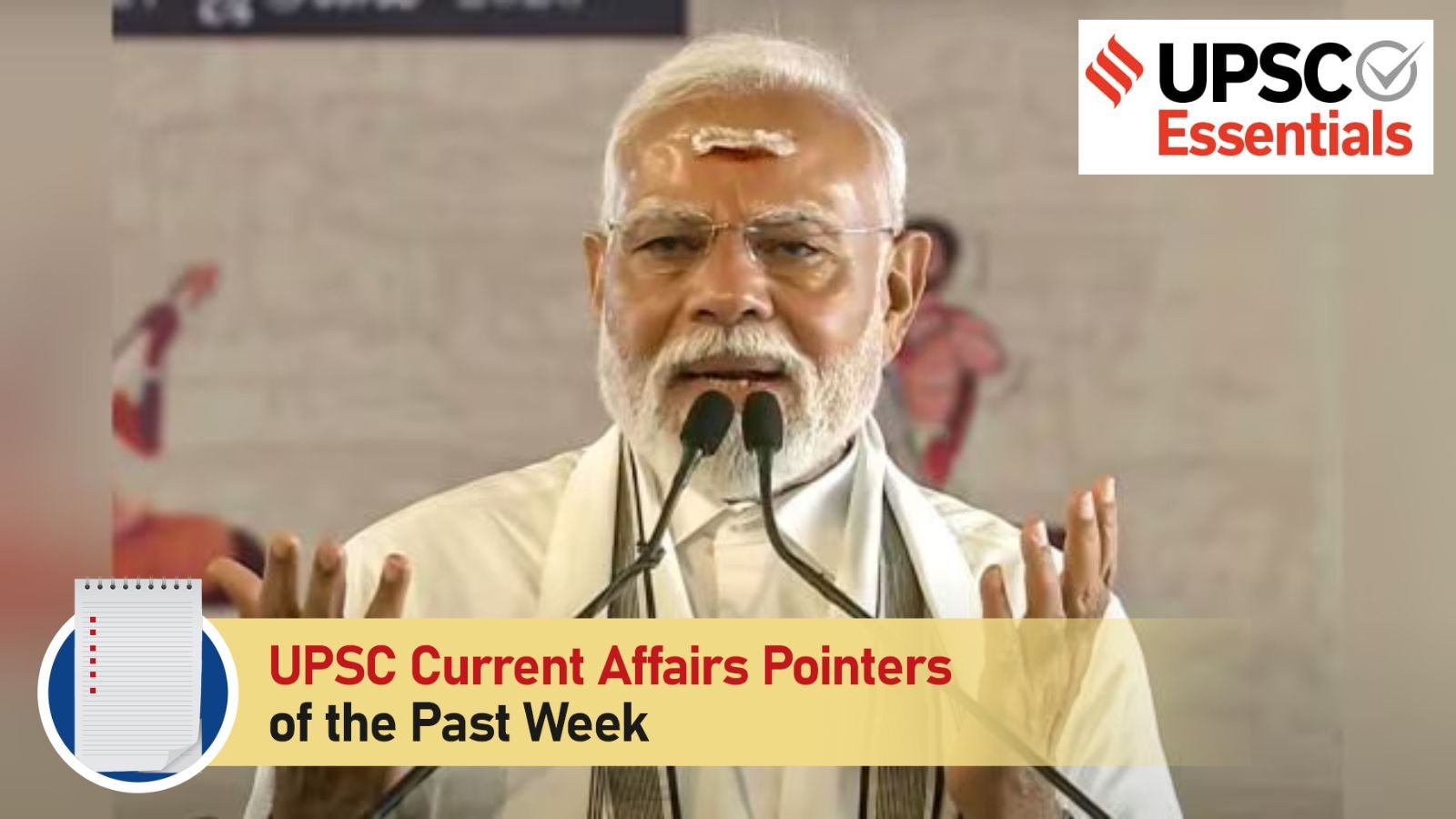
Every Monday, UPSC Current Affairs Pointers in UPSC Essentials aim to go beyond the headlines and provide content relevant to your UPSC Prelims, State PCS, and other competitive examinations.
Reports/Indices
(FYI: The data provided in these reports can be used to substantiate your Mains answer and create a broad understanding of the topic.)
— The Financial Inclusion Index (FI-Index), which captures the extent of financial inclusion across the country, improved to 67 in March 2025 from 64.2 in March 2024, according to the Reserve Bank of India (RBI).
— The index captures information on various aspects of financial inclusion in a single value ranging between 0 and 100, where 0 represents complete financial exclusion and 100 indicates full financial inclusion.
— The index comprises three broad parameters — access, usage, and quality, having weight 35 per cent, 45 per cent and 20 per cent, respectively.
— The FI-Index has been constructed without any base year and as such it reflects cumulative efforts of all stakeholders over the years towards financial inclusion.
Story continues below this ad
— The World Bank prepared the report titled Towards Resilient and Prosperous Cities in India in close collaboration with the Ministry of Housing and Urban Affairs.
— It estimates that Indian cities will require $2.4 trillion by 2050 to build climate-resilient infrastructure and services.
— The report projects that the country’s urban population will nearly double to 951 million by 2050, and that by 2030, cities will account for 70 per cent of all new employment generated.
— In addition to the rapid pace of urbanisation, Indian cities will face two major shocks in a business-as-usual scenario — flooding and extreme heat.
Story continues below this ad
— According to the report, annual pluvial flood-related losses can amount to $5 billion by 2030 and $30 billion by 2070 if cities don’t invest in adaptation.
— Heat-related deaths can double to over 3 lakh each year by 2050 due to global warming and the urban heat island phenomenon.
— In the Henley Passport Index, created by the London-based global citizenship and residence advisory firm Henley & Partners, India climbed eight spots to rank 77th, up from 85th last year.
— The number of destinations Indian passport holders can now visit visa-free or with visa-on-arrival has increased marginally to 59 from 57.
Story continues below this ad
— Singapore holds the number one spot, offering visa-free travel to 193 destinations. Japan and South Korea are tied for second, each granting access to 190 countries.
— Seven European countries — Denmark, Finland, France, Germany, Ireland, Italy, and Spain — share the third spot with 189 destinations.
— The Henley Passport Index is a globally respected ranking of passports based on the number of destinations their holders can travel to without obtaining a visa in advance. The index is compiled using data from the International Air Transport Association (IATA) and is updated quarterly.
Polity
— A parliamentary panel has “strongly” recommended “immediate review and replacement” of the current administration of the NIRD&PR, a think tank under the Ministry of Rural Development (MoRD).
Story continues below this ad
— Established in 1958, it focuses on training, capacity building, research and policy advocacy, and runs academic programs in regular and distance modes. The courses include a Diploma in Rural Development Management and Tribal Development Management.
 Union Home Minister Amit Shah unveils the ‘National Cooperation Policy-2025’ at the Atal Akshay Urja Bhawan, in New Delhi on Thursday. MoS Civil Aviation Murlidhar Mohol and Union Minister Krishan Pal Gurjar also present. (ANI Photo/Jitender Gupta)
Union Home Minister Amit Shah unveils the ‘National Cooperation Policy-2025’ at the Atal Akshay Urja Bhawan, in New Delhi on Thursday. MoS Civil Aviation Murlidhar Mohol and Union Minister Krishan Pal Gurjar also present. (ANI Photo/Jitender Gupta)
— Union Home Minister Amit Shah has unveiled a new national cooperative policy, replacing one in place for the past 23 years.
— The history of the cooperative sector dates back to before Independence, with a Cooperative Credit Societies Act enacted in 1904.
— In 2017, the Ministry of Cooperation was formed as a separate ministry. From 1979 till then, the cooperatives department fell under the Agriculture Ministry. The new ministry, Sahkarita Mantralaya, was formed with the vision to be ‘Sahakar se Samriddhi (Prosperity through Cooperation)’.
Story continues below this ad
— Recently, the foundation stone of India’s first national cooperative university, Tribhuvan Sahkari University, was laid down at the Institute of Rural Management Anand (IRMA) in Gujarat.
— On the occasion of Kargil Diwas, which is observed on July 26 every year, the National Legal Services Authority (NALSA) has announced a ‘Veer Parivar Sahayata Yojana’ to provide free legal aid to the families of soldiers.
— Free legal aid will be provided to ex-servicemen and serving soldiers and their families in the legal services clinic.
— On this day in 1999, the Indian Army announced the successful culmination of ‘Operation Vijay’, declaring victory after a nearly three-month-long battle in the icy heights of Kargil.
Story continues below this ad
Art & Culture
— Recently, the Trans-Giri region in Himachal Pradesh witnessed a centuries-old customary practice, a polyandrous tradition locally known as ‘Jodidaran’.
— It is practised by Hatti tribes, which were granted the status of Scheduled Tribes (STs) by the Centre in 2022.
— The Hattis are a close-knit community who got their name from their tradition of selling homegrown vegetables, crops, meat and wool etc. at small markets called ‘haat’ in towns. The Hattis are governed by a traditional council called Khumbli, which like the khaps of Haryana, decide community matters.
— Their practice of polyandry has roots in the desire to preserve undivided family land, particularly agricultural land.
Story continues below this ad
— Polyandry and polygamy are outlawed by the Special Marriages Act, the Hindu Marriage Act, 1955 and criminalised under the Bharatiya Nyaya Sanhita.
— The Constitution, under Article 342, recognises STs and accords them a distinct legal status. It recognises the relevance of prevailing customary laws among STs.
 Prime Minister Narendra Modi releases a commemorative coin honouring great Chola emperor Rajendra Chola I, during the valedictory celebrations of the Aadi Thiruvathirai festival. (DD/ANI Video Grab)
Prime Minister Narendra Modi releases a commemorative coin honouring great Chola emperor Rajendra Chola I, during the valedictory celebrations of the Aadi Thiruvathirai festival. (DD/ANI Video Grab)
— Gangaikonda Cholapuram temple is the site of the annual Aadi Thiruvadhirai festival (23rd to 27th July 2025). Aadi is the name of the month, and Thiruvadhirai is a nakshatra (arrangement of stars and planets) linked to Lord Shiva, also believed to be Rajendra Chola I’s birth star.
— This Aadi Thiruvathirai Festival this year also commemorates 1,000 years of the legendary maritime expedition of Rajendra Chola I to South East Asia.
— The Prime Minister released a commemorative coin featuring Rajendra Chola at the event.
— It is worth noting that the earliest references to the Cholas date as far back as the third century BCE, and were made by the Mauryan emperor Ashoka. However, very little evidence exists about the early Cholas, apart from the early Tamil literature of the third Sangam, and the references made about them in an ancient Graeco-Roman periplus written in the early centuries of the Common Era.
— After a long eclipse, the Chola Empire as we know it in all its glory, emerged sometime in the mid ninth century under King Vijayalaya Chola. The dynasty of Vijayalaya left behind a vast number of stone inscriptions and some copper plate grants, which has, in the last few decades, been the main source for reconstructing the history of the Cholas.
| A chapter from the History |
| Paika Rebellion is in the news after former Odisha Chief Minister Naveen Patnaik expressed concern over the “omission” of the Paika Rebellion from the latest Class VIII history textbook of the NCERT. The NCERT has clarified that the 1817 rebellion will be included in the second volume of the textbook, set to be released in September-October.
The Paikas (pronounced “paiko”, literally “foot soldiers”) were a class of military retainers who had been recruited from various social groups by the Gajapati rulers of Odisha since the 16th century. They would render martial services to the king in return for hereditary rent-free land (nish-kar jagirs) which they would cultivate during peacetime. Click here to know: Why did they rebel against the British? |
International Cooperation
 Union Minister of Commerce and Industry Piyush Goyal and UK Secretary of State for Business and Trade Jonathan Reynolds after inking the India-UK CETA in London on Thursday. ANI
Union Minister of Commerce and Industry Piyush Goyal and UK Secretary of State for Business and Trade Jonathan Reynolds after inking the India-UK CETA in London on Thursday. ANI
— On July 24, the India-UK Comprehensive Economic and Trade Agreement (CETA) was signed. It ensures comprehensive market access for goods across all sectors, covering all of India’s export interests.
— It will raise the total volume of trade to around $34 billion per annum from the present levels of around $2-25 billion.
— For the first time, India has allowed duty cuts for UK-origin alcohol, including whisky, brandy, rum, vodka, liqueurs, mead, cider, and tequila.
— In a first, India has allowed UK firms to participate in government tenders, offering them Class Two status under ‘Make in India’ rules, which require 20-50 per cent domestic value addition.
Note: One of the major points of contention between the two countries that led to the delay in the agreement is the UK’s Carbon Border Adjustment Mechanism (CBAM). Click here to learn about it.
Environment
— Union Agriculture Minister Shivraj Singh Chouhan last week wrote to Chief Ministers of all states to immediately stop the “forced tagging” of nano-fertilisers or biostimulants along with conventional fertilisers.
— Biostimulants are substances that stimulate physiological processes in plants and help enhance the yield from a harvest. Plant-derived waste materials and seaweed extracts are at times used in their production.
— In India, fertilisers and pesticides are governed by the 1985 Fertiliser Control Order and the Insecticides Act of 1968, respectively. In February 2021, the ministry amended the 1985 FCO and included biostimulants, paving the way for their regulated manufacturing, sale, and import.
— The FCO classified biostimulants specified in Schedule VI of the FCO in eight categories, including botanical extracts (as well as seaweed extracts), bio-chemicals, vitamins, and antioxidants.
— On April 9, 2021, the agriculture ministry constituted the Central Biostimulant Committee for five years, with the Agriculture Commissioner as its Chairperson and seven other members.
— Under the FCO, it shall advise the Centre on: (i) inclusion of a new biostimulant; (ii) specifications of various biostimulants; (iii) methods of drawing of samples and its analysis; (iv) minimum requirements of laboratory; (v) method of testing of biostimulants; (vi) any other matter referred to it by the central government.
Science and Technology
— ISRO will launch three navigation satellites (NVS-03, NVS-04, and NVS-05) for its Indian Regional Navigation Satellite System (IRNSS) by next year, according to a reply in Parliament by the Union MoS for Space Dr Jitendra Singh.
— The IRNSS was envisioned as a seven-satellite constellation that could provide navigation services over the Indian landmass and a radius of 1,500km around it. However, only four of India’s seven satellite navigation systems continue to provide location data.
— IRNSS is operationally referred to as the Navigation with India Constellation (NavIC) system. It is India’s regional Global Navigation Satellite System (GNSS).
— The NavIC satellites provide two types of services – Standard Positioning Service which is for general and commercial use, and Restricted Service which is meant for the defence forces – over the Indian landmass and neighbouring regions.
Defence
— The Indian Army has received three Apache attack helicopters from American aerospace company Boeing. The company delivered the AH-64E Apaches choppers as part of a contract to supply six helicopters to the Indian Army.
— The AH-64 Apache, which is one of the most advanced multi-role combat helicopters in the world, is currently flown by the US Army.
 The MiG-21 F-13 aircraft inducted into the Indian Air Force in 1963 was stationed in Chandigarh.
The MiG-21 F-13 aircraft inducted into the Indian Air Force in 1963 was stationed in Chandigarh.
— The Russian-origin MiG-21 fighter jets are set to be phased out of service in September this year. The Indian Air Force had earlier announced plans to replace the squadrons with the indigenously developed Tejas Mark-1A aircraft.
— India procured more than 700 MiG-21 aircraft of different variants, such as the Type-77, Type-96, BIS and the Bison, since the aircraft’s induction in the IAF in 1963.
— The MiG-21s are among the six fighter jets flown by the Indian Air Force (IAF), and have for long been the backbone of the IAF.
— The MiG-21s are single-engine, single-seater multi-role fighter/ground attack aircraft. While they were first inducted in 1963 as an interceptor aircraft, over the next few decades they were upgraded to perform a variety of roles performed by a fighter aircraft, including ground attack.
Diseases
(Just FYI: UPSC has consistently included questions on health and diseases in its examinations over the years. For instance, in 2014, a question about the Ebola virus appeared in the Prelims, and in 2017, a question about the Zika virus was featured. Therefore, it is crucial to stay updated on diseases that are currently in the news.)
 Malaria is a parasitic infection transmitted by mosquitoes, typically causing symptoms such as fever, chills, night sweats, nausea, vomiting, and diarrhoea. (File photo)
Malaria is a parasitic infection transmitted by mosquitoes, typically causing symptoms such as fever, chills, night sweats, nausea, vomiting, and diarrhoea. (File photo)
— The Indian Council of Medical Research (ICMR) has developed a vaccine called AdFalciVax. It is seen as a promising candidate for Malaria vaccines.
— AdFalciVax is a chimeric recombinant vaccine — a type of vaccine that uses different parts of the genes of a pathogen (in this case, Plasmodium) to create target proteins that trigger an immune response after being injected.
— It uses two types of target proteins to prevent the spread of infection in two different ways: circumsporozoite protein (CSP) and Pro6C protein.
— AdFalciVax also contains an adjuvant — a substance used in vaccines to boost the body’s immune response against the targeted disease — called alum. The use of alum is beneficial as it does not pose a risk of causing chronic inflammation, unlike adjuvants such as AS01 and Matrix M, which are used in RTS,S and R21.
— Malaria is a parasitic infection transmitted by mosquitoes, typically causing symptoms such as fever, chills, night sweats, nausea, vomiting, and diarrhoea.
— Malaria is most endemic in Africa — Nigeria, Congo, Tanzania, Mozambique, Niger, and Burkina Faso together account for more than half the yearly deaths.
The disease is also present in India, although malaria deaths have sharply reduced in the country in recent years.
— Recently, two vaccines—RTS,S and R21—were approved for Malaria vaccine, but their efficacy, at 75%, is quite low.
Persons in News
(Just FYI: Noting historical personalities’ anniversaries aids UPSC prep. UPSC often includes such personalities in questions, so revisiting their lives refreshes your static syllabus.)
— Indian-American economist Gita Gopinath, who is serving as the first deputy managing director at the International Monetary Fund (IMF), announced that she is stepping down from her position and returning to her academic career.
— Gita Gopinath is an Indian-American economist, currently serving as the first deputy managing director at the International Monetary Fund (IMF) since January 21, 2022.
 V.S. Achuthanandan with Pinarayi Vijayan.(Express Archive)
V.S. Achuthanandan with Pinarayi Vijayan.(Express Archive)
— Founding member of the CPI(M) and former Kerala chief minister Velikkakathu Sankaran Achuthanandan died on 21st July. Popularly known as Comrade VS or just VS, Achuthanandan was 101 years old.
— Achuthanandan, who served as Kerala chief minister from 2006 to 2011, had stayed away from public life since 2019, after suffering a stroke.
— The government has appointed Ajay Seth, former Finance Secretary and Secretary of the Department of Economic Affairs (DEA), as the new Chairman of the Insurance Regulatory and Development Authority of India (IRDAI).
— Established in 1999 as an autonomous and statutory body, the IRDAI serves as the primary regulator for the insurance industry in the country and abroad. Its main objective is safeguarding policyholders’ interests and ensuring the insurance industry’s growth and stability.
— Uma Kanjilal has been appointed as the Vice Chancellor of the Indira Gandhi National Open University (IGNOU), becoming the first woman to hold the post since the university’s establishment in 1985.
Places in News
(Just FYI: The location of the place is important, considering that UPSC has asked several questions about places that were in the news, such as Aleppo and Kirkuk, in the 2018 UPSC Prelims. The best way to remember them is to plot them on a world map.)
— Thailand’s army launched strikes on Cambodian military sites along their disputed border on July 24, amidst recent deadly clashes which killed at least 11 Thai civilians. Preah Vihear temple is one of the disputed center.
— It is an 11th-century Hindu temple of Preah Vihear, located between Cambodia’s Preah Vihear province and Thailand’s Sisaket province. Both countries have claimed the temple dedicated to Lord Shiva as their own.
— The structure consists of five “gopuras” (gateways) linked by a series of stairways and corridors with several basins, and reservoirs. Shiva’s vehicle–the bull, popularly known as Nandi, is found facing the entrance of the temple.
— Apart from the temple complex, there are other archaeological sites that are related to the temple but are situated in Thailand. These include Sa Trao, an ancient reservoir, and a small bas-relief engraved on natural sandstone depicting a Shiva Lingam enclosed within a Yoni Base.
— It is recognised as a UNESCO World Heritage site of Cambodia.
— The temple is located about 400 km northeast of Bangkok, along the border of Thailand’s Surin province and Cambodia’s Oddar Meanchey province.
— The temple is a Khmer archaeological complex built by King Jayavarman VII and comprises three buildings.
— The main temple, Prasat Ta Muen Thom, is made of sandstone and features a shivalinga, as well as libraries.
— The complex also features Prasat Ta Muen, the Mahayana Buddhist religious site meant to offer refuge to travellers, and Prasat Ta Muen Tot, the hospital shrine for the local community.
— Calling it the “project of the century,” Beijing has announced the construction of the world’s biggest hydropower dam on the Yarlung Tsangpo River in Tibetan territory.
— The dam has drawn criticism from the lower riparian states of India and Bangladesh as well as Tibetan groups and environmentalists.
— The Yarlung Tsangpo is the largest river on the Tibetan plateau, originating from a glacier near Mount Kailash. ‘Tsangpo’ means river in Tibetan.
— The basin spreads over more than 500,000 sq km of land in China, India, Bhutan, and Bangladesh, “though 80% of it lies in China and India.”
— One fascinating feature of the river is the sharp ‘U’ turn that it takes, known as the Great Bend, at the proximity of Mount Namcha Barwa near the Indian border.
— In India, the Yarlung Tsangpo enters Arunachal Pradesh as Siang. The Siang then gathers more streams and flows down towards Assam where it is joined by the Lohit and Dibang rivers. Further downstream, it is known as the Brahmaputra, which in turn flows through Assam before entering Bangladesh.
— China has constructed several dams along tributaries of the Yarlung Tsangpo, such as the Pangduo and Zhikong dams on the Lhasa River.
 Gangaikondacholapuram built by Rajendra Chola as the capital of the Chola Empire in the beginning of the 11th century CE. (Wikimedia Commons)
Gangaikondacholapuram built by Rajendra Chola as the capital of the Chola Empire in the beginning of the 11th century CE. (Wikimedia Commons)
— Prime Minister Narendra Modi on Sunday (July 27) offered prayers at the ancient Shiva temple of Gangaikonda Cholapuram in Tamil Nadu.
— The Gangaikonda Cholapuram Shiva temple, a UNESCO World Heritage Site, is often considered the pinnacle of Chola architecture.
— Rajendra Chola I, who reigned for 30 years (1014 to 1044 AD), built Gangaikonda Cholapuram as his capital after his Army marched right up to the Ganga river, defeating the Pala kingdom of Bengal, and returned victorious.
— In this new town, he built a grand water tank and a grander temple. The tank, Cholagangam, was meant to be a Ganga-jalamayam jayasthambham, or “a liquid pillar of victory”.
Sports
 57th International Chemistry Olympiad 2025 Team India (Image via Press Information Bureau)
57th International Chemistry Olympiad 2025 Team India (Image via Press Information Bureau)
— India’s four-member student delegation to the 57th International Chemistry Olympiad (IChO) 2025 has returned with two gold and two silver medals.
— The competition was held in Dubai, United Arab Emirates, from July 5 to 14, and featured participation from 354 students representing 90 countries, along with five observer nations.
— The gold medal winners from India are Devesh Pankaj Bhaiya from Jalgaon, Maharashtra, and Sandeep Kuchi from Hyderabad, Telangana.
— Debadatta Priyadarshi from Bhubaneshwar, Odisha, and Ujjwal Kesari from New Delhi earned silver medals.
— India secured the sixth position in the overall medal tally, along with countries such as Ukraine, Uzbekistan, Kazakhstan, and Israel.
Test Your Knowledge
(Note: The best way to remember facts for UPSC and other competitive exams is to recall them through MCQs. Try to solve the following questions on your own.)
(1) AdFalciVax, R21, and RTS,S seen in the news, are associated with
(a) New variant of gene-edited cotton with resistance against pink bollworm
(b) Medicines for the treatment of Lyme disease
(c Real Time Sensors variants
(d) Vaccines for the treatment of Malaria
(2) Consider the following:
1. Originates from a glacier near Mount Kailash
2. Makes a sharp ‘U’ turn at the proximity of Mount Namcha Barwa
3. Dibang is one of the tributaries
4. Pangduo dam is constructed on this River
The above description aptly describes which river?
(a) Krang Ponley River
(b) Yarlung Tsangpo
(c) Ayeyarwady River
(d) Penna River
(3) The ‘Towards Resilient and Prosperous Cities in India’ report was published by the Union Ministry of Housing and Urban Affairs in collaboration with
(a) World Bank
(b) Asian Development Bank
(c) World Meteorological Organization
(d) BIMSTEC Secretariat
| Prelims Answer Key |
| 1. (d) 2. (b) 3. (a) |
For your suggestions and feedback, write to khushboo.kumari@indianexpress.com
Subscribe to our UPSC newsletter. Stay updated with the latest UPSC articles by joining our Telegram channel – IndianExpress UPSC Hub, and follow us on Instagram and X.
🚨 Click Here to read the UPSC Essentials magazine for July 2025. Share your views and suggestions in the comment box or at manas.srivastava@indianexpress.com🚨







